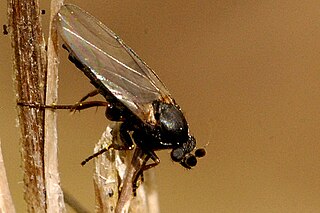
Peripatus is a genus of velvet worms in the Peripatidae family. The name "peripatus" is also used to refer to the Onychophora as a whole, although this group comprises many other genera besides Peripatus. The genus Peripatus is found in Central America, the Caribbean and northern South America.

The Stephanidae, sometimes called crown wasps, are a family of parasitoid wasps. They are the only living members of the superfamily Stephanoidea. Stephanidae has at least 345 living species in 11 genera. The family is considered cosmopolitan in distribution, with the highest species concentrations in subtropical and moderate climate zones. Stephanidae also contain four extinct genera described from both compression fossils and inclusions in amber.
The Wisconsin State Open is the Wisconsin state open golf tournament, open to both amateur and professional golfers. It is organized by the Wisconsin section of the PGA of America. It has been played annually since 1919 at courses in the state. It was considered a PGA Tour event in the mid-1930s.
Epiperipatus is a genus of Neotropical velvet worms in the Peripatidae family.

The Metopininae are a subfamily of flies in the family Phoridae.

Electrostephanus is an extinct genus of crown wasp in the hymenopteran family Stephanidae, and is the only genus placed in the subfamily Electrostephaninae. The genus contains four described species, E. brevicornis, E. neovenatus, E. janzeni, and E. petiolatus, placed in two subgenera E. (Electrostephanus) and E. (Electrostephanodes). Electrostephanus is known from several middle Eocene fossils which have been found in Europe.

Rhopalosoma is a genus of wasps in family Rhopalosomatidae. Members of this family are parasitic of crickets.
Epiperipatus imthurni is a species of velvet worm in the family Peripatidae. The type locality is in Guyana. No males have been recorded from this species. Females have 28 to 32 pairs of legs, usually 30 or 31. Females from Trinidad were shown to reproduce via parthenogenesis; the only velvet worm known to do so.
Epiperipatus barbouri is a species of velvet worm in the Peripatidae family. Females of this species have 30 to 34 pairs of legs. The type locality is in Grenada.
Epiperipatus trinidadensis is a species of velvet worm in the Peripatidae family. Males of this species have 27 to 30 pairs of legs; females have 29 to 32. The type locality is in Trinidad.
Epiperipatus vagans is a species of velvet worm in the Peripatidae family. The male of this species has 29 pairs of legs; females have 30 to 33. The type locality is in Panama.
Paraperipatus lorentzi is a species of velvet worm in the Peripatopsidae family. The male of this species has 21 pairs of legs; females have 22 or 23 pairs of legs. The type locality is in Western New Guinea, Indonesia.

Anevrina is a genus of phorid flies circumscribed by the Italian naturalist Paolo Lioy in 1864.

Phalacrotophora is a genus of scuttle flies. There are at least 50 described species in Phalacrotophora.
Beckerina is a genus of flies in the family Phoridae.

The Metopininae is a tribe of flies in the family Phoridae.
Ecitomyia is a genus of flies in the family Phoridae.
Trophithauma is a genus of flies in the family Phoridae.
Brachyscelio is an extinct genus of wasps belonging to the family Neuroscelionidae, fossils have been found in Baltic and Rovno amber.






